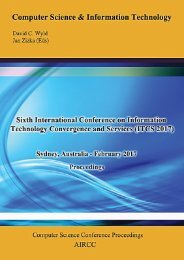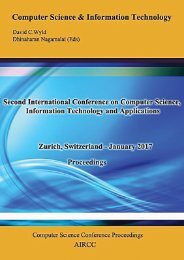CoSIT 2017
Fourth International Conference on Computer Science and Information Technology ( CoSIT 2017 ), Geneva, Switzerland - March 2017
Fourth International Conference on Computer Science and Information Technology ( CoSIT 2017 ), Geneva, Switzerland - March 2017
You also want an ePaper? Increase the reach of your titles
YUMPU automatically turns print PDFs into web optimized ePapers that Google loves.
Computer Science & Information Technology (CS & IT) 153<br />
the name of the filer, the particular central index key, the date and the type of the submission as<br />
well as the particular name of the document on the SEC server. In general, four different types of<br />
index files are available sorting the filings made on EDGAR by company name, form type,<br />
central index key or by submissions containing financial statements formatted in eXtensible<br />
Business Reporting Language (XBRL) [31] [32]. When examining the form index files more<br />
precisely one can see that the index files do not only contain the name of any filing made on<br />
EDGAR but rather the (entire) server path. Table 4 illustrates an excerpt of information stated in<br />
the SEC EDGAR form index file from the first quarter of 2016. By opening the index files for<br />
example with a simple MS Excel spreadsheet (file extension *.xlsx) a Uniform Resource Locator<br />
(URL) can be created for each financial statement which is listed in a particular index file since<br />
the name of the filing and its (partial) server path (directory) is stated. To do so the protocol<br />
(https://), the hostname (www.sec.gov/) and a link to the archives directory (Archives/) have to be<br />
added to the file name from the index file. Table 5 illustrates the URL components of Coca<br />
Cola´s 2015 annual report on Form 10-K filed with the SEC on February 25, 2016. These URLs<br />
which have been composed based on the EDGAR index files can be copied into a plain text file<br />
(file extension *.txt). By opening it with the browser extensive data (financial statements) can be<br />
retrieved from the SEC and its EDGAR system in a fast and efficient way using a browser<br />
extension (however, the composed URLs can also be implemented in any other data gathering<br />
method).<br />
This method offers various significant advantages. First, for many people composing URLs with<br />
commonly used and easy accessible computer software like MS Excel is simpler and faster than<br />
relying on complex coding languages to identify and retrieve the documents in question.<br />
Secondly, since multiple documents can be retrieved at the same time using browser extensions,<br />
the described method is again a lot faster especially when obtaining massive data from EDGAR.<br />
Thirdly, by sorting or filtering the different index files in MS Excel the proposed method can<br />
easily be adjusted to retrieve another filing form type or data from another company. The result of<br />
this procedure is validated through obtaining exactly the same financial statements investors and<br />
researchers would retrieve using a complex, slow and error-prone alternative.<br />
4. HYPERTEXT MARKUP LANGUAGE IN SEC FILINGS<br />
Because financial statements filed with the SEC are formatted in HyperText Markup Language<br />
(HTML) the fundamentals of HTML are illustrated first, followed by an examination of the data<br />
formatted in HTML provided by the SEC and its EDGAR system.<br />
4.1. Fundamentals of HyperText Markup Language<br />
HyperText Markup Language (HTML) is a universally understood digital language which is used<br />
to publish and distribute information globally. HTML is the publishing language of the World<br />
Wide Web [33]. HTML is used to create HyperText documents that are portable from one<br />
platform to another [34] due to their generic semantics as a Standard Generalized Markup<br />
Language (SGML) application [33]. HTML enables authors to publish documents online, assign a<br />
specific look or layout to document content (tagging) [35] [21] or to retrieve information online<br />
via HyperText links [33]. The World Wide Web Consortium (W3C) is maintaining and<br />
specifying the vocabulary (applicable markups) and grammar (logical structure) of HTML<br />
documents [35].





